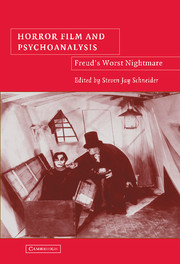Book contents
- Frontmatter
- Contents
- Acknowledgments
- Foreword: “What Lies Beneath?”
- Introduction: “Psychoanalysis in/and/of the Horror Film”
- PART ONE THE QUESTION OF HORROR-PLEASURE
- PART TWO THEORIZING THE UNCANNY
- PART THREE REPRESENTING PSYCHOANALYSIS
- PART FOUR NEW DIRECTIONS
- 12 Doing Things with Theory: From Freud's Worst Nightmare to (Disciplinary) Dreams of Horror's Cultural Value
- 13 The Darker Side of Genius: The (Horror) Auteur Meets Freud's Theory
- 14 Violence and Psychophysiology in Horror Cinema
- Afterword: Psychoanalysis and the Horror Film
- About the Contributors
- Bibliography
- Index
14 - Violence and Psychophysiology in Horror Cinema
Published online by Cambridge University Press: 14 July 2009
- Frontmatter
- Contents
- Acknowledgments
- Foreword: “What Lies Beneath?”
- Introduction: “Psychoanalysis in/and/of the Horror Film”
- PART ONE THE QUESTION OF HORROR-PLEASURE
- PART TWO THEORIZING THE UNCANNY
- PART THREE REPRESENTING PSYCHOANALYSIS
- PART FOUR NEW DIRECTIONS
- 12 Doing Things with Theory: From Freud's Worst Nightmare to (Disciplinary) Dreams of Horror's Cultural Value
- 13 The Darker Side of Genius: The (Horror) Auteur Meets Freud's Theory
- 14 Violence and Psychophysiology in Horror Cinema
- Afterword: Psychoanalysis and the Horror Film
- About the Contributors
- Bibliography
- Index
Summary
Film studies is, and has been, deeply involved with cultural categories of explanation. Features of cinema, such as the shot/reverse-shot series, are explicated in terms of ideology and the propagation of a socially determined dominant discourse. The viewer's involvement with cinema has also tended to be framed in terms of culturally construed models of psychology, such as psychoanalysis. I refer to psychoanalysis as culturally construed for two reasons. The first involves the conditions of its origin: Freud as a late Romantic philosopher/scientist whose brilliant work is not separable from the parameters of the bourgeois, patriarchal era in which he lived, and whose project was to substitute a new paradigmatic ideal – the self, the psyche – for those previously holding sway in Western culture. Philip Rieff describes this as the replacement of religion, politics, and economics by “psychological man” (356–57).
Psychoanalysis has also operated within the arena of film studies to advance certain large-scale analyses of cinema's cultural impact, viewed in terms of the mobilization of desire within the medium's mass audiences. Since the 1970s, film studies' appropriation of psychoanalysis has been tied to the efforts of film scholars to explain how cinema connects desire (at the level of individual viewers) to ideology (at the level of social discourse). Allied with the ideological study of cinema found in Marxist or feminist approaches, psychoanalysis has provided film scholars with a method for connecting cinema's operations to the individual spectator as well as to social formations.
- Type
- Chapter
- Information
- Horror Film and PsychoanalysisFreud's Worst Nightmare, pp. 241 - 256Publisher: Cambridge University PressPrint publication year: 2004
- 1
- Cited by



